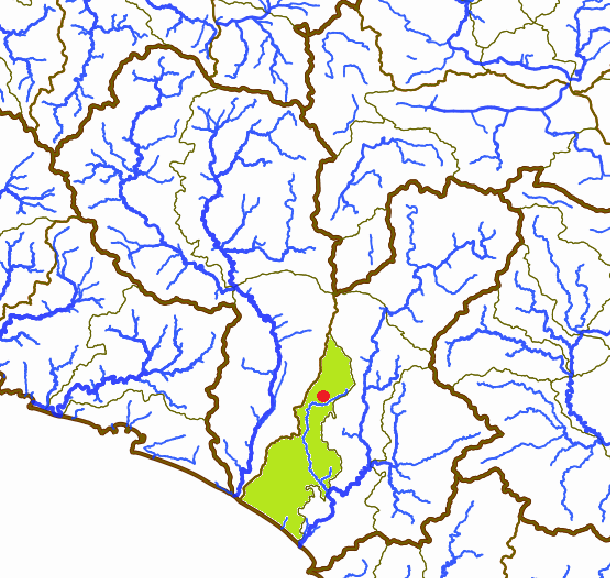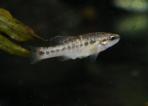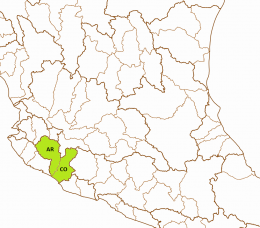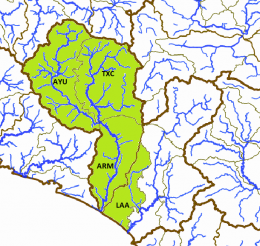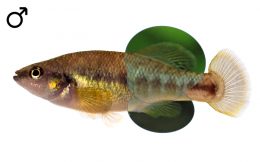- HOME
- WHO WE ARE
- NEWS AND DATES
- GOODEIDS
- PHYLOGENY
- ARTIFICIAL KEY
- GOODEID SPECIES
- BIOLOGY
- ENVIRONMENT
- CONSERVATION
- PROFUNDULIDS
- MEMBERS AREA
Allodontichthys zonistius
English Name:
Bandfin or Banded Splitfin
Mexican Name:
Mexclapique (erronously: Mexcalpique) de Armería
Original Description:
HUBBS, C. L. (1932): Studies of the Fishes of the Order Cyprinodontes. XI. Zoogoneticus zonistius, a new Species from Colima, Mexico. Copeia, 1932, No. 2: pp 68-71
Holotype:
Collection-number: Museum of Comparative Zoology, Cat. No. MCZ-32818.
The Holotype is an adult male of 44mm standard length, collected by Gustav Glückert (1913) and donated to the Museum on November the 1st, 1913. The Paratype, another male (48mm), with Cat. No. UMMZ-97316 is part of the collection at the University of Michigan Museum of Zoology.
Photo of the Holotype (left) and Paratype (right) of Allodontichthys zonistius:
Terra typica:
Carl L. Hubbs only mentioned, that the two male specimens of the description (Holotype and Paratype) were collected in Colima, Mexico. Clarence Turner (1946) specified the type location a bit more with "a tributary of the Río Colima near the city of Colima". He himself collected the first three females (Cat. No. UMMZ-143021) of this species from the Río Colima about 300 yards (275m) from the Colima railway station, all of them between 21-30mm long, and another one (Cat. No. UMMZ-143020) from Villa de Álvarez north of Colima, 39.5mm long (02.04.1939).
Etymology:
The species epithet can be derived from the Greek and means: "with a banded sail", which is referring to the black-banded dorsal fin: ζώνη (zóna = zone, belt or banding) and Ιστίον (istíon = sail)
The genus Allodontichthys was erected by C. L. Hubbs and C. L. Turner in 1939 to distinguish this genus from the genus Zoogoneticus "chiefly on the basis of the form of the jaw teeth, which instead of being regularly conic (everywhere evenly round in cross section) are definitely compressed and shouldered within the slender conic tip and are keeled (rather weakly) at either edge of the anterior face." The generic name is derived from the ancient Greek language. The word ἄλλος (állos) means different, ὀδόντος (ódóntos) is the genitive of ὁδούς (ódoús), the tooth. The last part of the name, ἰχθύς (ichthus, ichthys), is the Greek word for fish, so the name of the genus can be translated into "a fish with a different tooth".
Synonyms:
Zoogoneticus zonistius Hubbs, 1932
Alloophorus zonistius Turner, 1937
Distribution and ESU's:
The Bandfin Splitfin is endemic to the Mexican federal states of Jalisco and Colima and was originally described from the vicinity of Colima, probably from the Río Colima, Río Armería drainage. In the following decades it was additionally discovered in several affluents of the Río Armería and in one affluent of the Río Salado, Río Coahuayana drainage. As known so far, its geographic range encompasses the Río Ayuquila, the upper Río Armería to about its junction with the Río de la Lumbre (about 15km NNW of Colima) including the Río de la Lumbre itself, the Río Tuxcacuesco about its junction with the Río Ayuquila up to its headwaters (like the Arroyo San Pedro), and two main affluents of the Río Ayuquila (arroyos Ahuacapán and Manantlán), all from the upper Río Armería drainage. It also occurs in the headwaters of the Río Colima and the Barranca de la Tía Barragana and Arroyo El Carrizal (Río Comala sources) about the town of Comala, middle Río Armería drainage, and due to a relatively recent stream capture (Lyons and Mercado-Silva, 2000; Webb, 2002) in the Río Coahuayana system near the town of Cuauhtemoc, namely in the Arroyo Cardona, Río Salado drainage, and two of its affluents, the Arroyo Grande and the Río El Cobano. According to the affiliation to two distinct rivers systems, two subpopulations, the Río Armería subpopulation (type subpopulation) and the Río Salado subpopulation can be distinguished. The bold names are the ones officially used by the Instituto Nacional de Estadística y Geografía; nevertheless, other ones might be more often in use or better known and therefore prefered.
ESU ist short for Evolutionarily Significant Unit. Each unit expresses an isolated population with different genetic characteristics within one species. ESU's can be defined by Molecular genetics, Morphology and/or Zoogeography and help in indicating different phylogenetic lineages within a species. The abbreviation for an ESU is composed of the first 3 letters of the genus, followed by the first 2 letters of the species name and an ongoing number in each species.
In Allodontichthys zonistius, it is not possible to distinguish different ESU's, so there is only one recognized: Aldzo1
The left map shows the ríos Coahuayana (CO) and Armería (AR) basins from the Hydrographic Region Armería-Coahuayana on a Mexico map. Within the Río Armería basin, the Bandfin Splitfin occurs in all three subbasins: The Río Armería subbasin (ARM) and its two headwater regions, the ríos Ayuquila (AYU) and Tuxcacuesco subbasins (TXC). Furthermore, as a result of stream capture, it is distributed in the Lagunas Alcuzahue y Ámela subbasin (LAA) of the Río Coahuayana basin. The right map shows the inhabited subbasins:
Status :
International Union for Conservation of Nature (IUCN): Vulnerable
Distribution and current conservation status of the Mexican Goodeidae (Lyons et al., 2019): Vulnerable/stable: „Known from 12 locations in the Armería River basin and two nearby areas in the lower Coahuayana River basin, which originated from a relatively recent stream capture (Lyons and Mercado-Silva, 2000; Webb, 2002). Improved water quality from a sugar mill discharge has led to increases in abundance in the Ayuquila River in the Armería basin near the city of Autlán, but these gains have been offset by population declines further downstream in the Armería River and its tributaries near the city of Colima.“
NOM-059-SEMARNAT-2010: no categoría de riesgo (no category of risk)
Habitat:
Like all other Allodontichthys-species, the Bandfin Splitfin can be found characteristically in clear riffles over substrates of gravel, rocks and boulders. It goes down to a depth of 1m, but prefers absolutely depths of less than 0.5m. During the dry season, the currents are slight to moderate, but surely turbulent during the rest of the year. The only form of vegetation associated with this species are green algae. In some areas, there can be found a lot of dead foliage where this species uses to hide beneath. Its habitats are similar to those of the North American darters (Percidae, genus Etheostoma) living among and under rocks in shallow waters.
On a survey of the GWG in November 2018, the group looked for this species in the Río Ayuquila directly in the city of Ayuquila, but was not able to find it. The only species occuring were non-native Largemouth Bass (Mictopterus salmoides), Sunfish (Lepomis sp.), Tilapia and Poeciliopsis gracilis. A survey of the GWG to areas around Colima in March 2019 found the species in the Arroyo Hondo, Río Salado drainage in good numbers and in a creek (Barranca de la Tía Barragana) in Comala, Río Armería drainage. The species seemed to prefer the river sections with big rocks and boulders, where it was hiding underneath big rocks. A survey of the GWG in June 2019, focusing on the Río Armería drainage, found good stocks in the Arroyo Manantlán close to its junction with the Río Ayuquila, in the Arroyo Tamazula at San Pedro, Río Tuxcacuesco drainage and in an affluent of the Río Colima above the city of Colima. While the habitat in the Manantlán creek was similar structured to the Arroyo Hondo with big boulders and rocks, the other habitats were composed of different sizes of rocks, riparian vegetation, but few boulders. However, the species seemed to prefer places with bigger rocky structures to hide beneath. The group surveyed additionally the Río Ayuquila at two places (at the Zenzontla bridge and close to its junction with the Tuxcacuesco river), but was not able to find a single specimen (and also no Ilyodon furcidens). Ilyodon furcidens occured in the Río Tuxcacuesco close to its junction with the Ayuquila river, but again no Allodontichthys zonistius.
Biology:
Turner collected gravid females on April 2nd, 1946 near Colima, so this species might reproduce from winter to the early spring. A survey of the GWG to the Arroyo Hondo in March 2019 revealed gravid females in different stages, and in the Arroyo Manantlán and next to Colima additionally in June.
The Arroyo Hondo at the survey spot in March 2019 was about 6 to 8m broad and about 50cm deep with a sandy bottom with gravel and some bigger rocks, where Amphilophus istlanus were schooling their fry. There were no Bandfin Splitfins to find, not even next to the rocks. About a 50m upstream, the character of the creek changed substantially. It became narrow (1 to 2m) and very rocky with big boulders. Here the group was able to find Allodontichthys zonistius hiding deep under the rocks, so they showed a similar behaviour to Allodontichthys polylepis and even hubbsi.
Diet:
The conical teeth and the short gut indicate carnivorous feeding habits. The studies of Turner found the guts of the related Allodontichthys tamazulae containing large insect larvae. Probably all species of Allodontichthys feed from insect larvae from the bottom of their habitats, detected between algae, slick and rocks.
Size:
The maximum known standard length is 63mm (Miller et al., 2005).
Colouration:
The females and males have the upper part of the body above the lateral line spotted with dark brown. The scales are blackened posteriorly, the obligate black comma-shaped Allodontichthys-spot behind the opercle is marked. Five black bars are crossing the dorsal fin, bordered narrowly by whitish. All females have wide, dark and fairly regular bars beginning well above the lateral line and extending well below it. There are 10-12 of these bars, the first just back of the eye and the last at the anterior end of the caudal fin. These markings have a rounded posterior and a straight anterior margin. The sides (of alcohol specimens) are purplish, except on the yellowish silver lower surface. The cheeks are golden, the opercle is greenish, the top of the head and muzzle is purple. The caudal fin has a light yellowish crescent behind a diffuse dark basal blotch; behind the light bar the fin is abruptly darkened by black membranes. The other fins are somewhat dusky.
Sexual Dimorphism:
At first appearance, males and females of the Bandfin Splitfin are not very easy to distinguish. The safest characteristic is the Splitfin in males, means the for Goodeinae typical mating organ formed by a notch after the first seven shortened rays of the Anal fin. Additionally, male Allodontichthys zonistius have a much bigger Dorsal fin than females, and it is usually more intensively coloured. A third character, but only visible when fish are feeling safe and relaxed, is the colour: males are brighter coloured (usually turquise) with the upper part of the body separated from the lower part by a series of vertical brown blotches, forming an irregular line and giving the fish a vertically striped appearance. Females are coloured duller with the upper from lower part of the body not so clearly separated.
Remarks:
Allodontichthys zonistius was the first discovered species of the genus Allodontichthys. It had originally been placed in the genus Zoogoneticus by Hubbs in 1932, but soon thereafter transferred into the genus Allodontichthys, erected by Hubbs & Turner in 1939, mainly because of its divergent dentition. Both authors assumed a narrow relationship of this genus to Ilyodon, but were not able to prove it as there was no female in the type material to study the ovarian characters. When Turner collected the first females in April 1939 in the Río Colima and studied the ovarian characters and trophotaenial features in unborn fry, he resolved the close relationship with Ilyodon and published the results in 1946.
The Banded Splitfin belongs to the fish fauna of the Río Armería drainage, nevertheless it can additionally be found in the Río Salado System, an affluent of the adjacent Río Coahuayana system. The reason therefore is a quite recent stream capture event caused by activities of the Colima volcano when its eruptive material redirected this river from the Río Armería to the Río Coahuayana basin. Like Allodontichthys hubbsi and tamazulae, its congeners from the Río Coahuayana, the Banded Splitfin is restricted to the cooler headwaters of its river, so this isolation barrier prevents the three species to meet each other downstream. The Río Colima and the Río Salado, though now belonging to two different drainages and populated with the same fish species, come next to the Colima volcano that close that there are some areas where the headwaters of both are separated by only 200m distance.
Husbandry:
Looking on the biotopes of Allodontichthys zonistius, they suggest the species may prefer a habitat with moderate to swift current, structured with gravel, rocks and boulders. Most breeders observed quite a high level of aggression between the adult fish, so the tank set up should prevent the fish from seeing each other all the time. Fry is eaten in some cases, but it may depend on the quantity and quality of food and on the number of places to hide. When several different stages of juveniles occur, fry may be neglected, so it makes sense to add separate brought up fry to the group with a size of 2 or 2.5cm to provide these stages and get a flock breeding colony.
The recommended tank size is at least 150 liters, bigger tanks with a generous base and little height (25cm are enough) are better for sure. With rocks well structured tanks combined with some roots and/or wood seem to do best with this species. The current should be moderate or swift, especially as the species is adapted to a high oxygene level (at least 8mg/l).
In the wild, the species feeds mainly from small or middle - sized invertebrates like bloodworms or insect larvae, so feeding with similar food, water fleas, Mysids and other food from animalistic sources will be best for this predatory fish. In aquarium, it feeds also well from flake food, granulate and even tablets, additionally given Nauplia of Brine Shrimps are eaten greedy and the species is not acting shy at all.
Concerning water quality, this species is in need of bigger water changes (60-80% every week) like most of the Goodeids, especially river inhabiting species, so an automatic water changing system can be helpful. Otherwise, in combination with constant temperatures higher than 24°C, fish may get sick, lose resistance against diseases and age too fast. So for keeping the strain healthy and strong, give the fish a rest during winter time with temperatures lower than 20°C for 2 or 3 months so they stop producing fry. In spring, when the temperature slowly increases, they will start spawning at 20 or 21°C and won't stop until it gets colder again or when it gets too warm (25°C).
This species does very well when is kept in the open from spring to fall, starting when the water temperature by day exceeds 17°C and cold periods are no longer expected. Bring them out in the early afternoon, the time of the day with the highest water temperature. During the warm summer, reproduction will stop and may occur again in fall. Bring the fish in before the water temperature deceeds 17°C by day and keep them cool for the first days, then slowly raise the temperature but try to stay below 20°C over the winter time.
Populations in holding:
Here each species are assigned populations of fish in husbandry and in brackets aliases of these locations to assist in identifying own stocks. Each population is assigned a unique Population-ID, composed by the ESU, the subbasin where this population is occurring (three capital letters) and a unique location identifier.
Populations in holding:
1. Aldzo1-AYU-AAhu
Population: Arroyo Ahuacapán
Hydrographic region: Armería-Coahuayana
Basin: Río Armería
Subbasin: Río Ayuquila
Locality: Arroyo Ahuacapán, at Ahuacapán
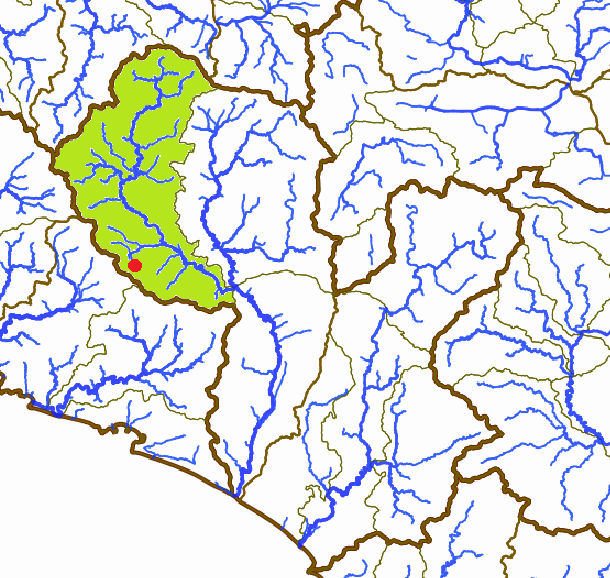
2. Aldzo1-AYU-RAyu
Population: Río Ayuquila
Hydrographic region: Armería-Coahuayana
Basin: Río Armería
Subbasin: Río Ayuquila
Locality: Río Ayuquila, at the bridge N of Zenzontla
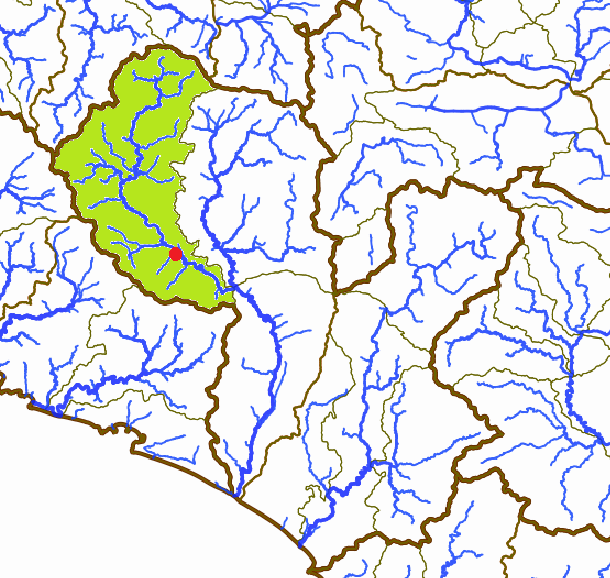
3. Aldzo1-AYU-AMan
Population: Arroyo Manantlán (aka: Manantlán)
Hydrographic region: Armería-Coahuayana
Basin: Río Armería
Subbasin: Río Ayuquila
Locality: Arroyo Manantlán, near junction with Río Ayuquila

4. Aldzo1-ARM-Com
Population: Comala (aka Barranca de la Tía Barragana, 1st. bridge in Comala)
Hydrographic region: Armería-Coahuayana
Basin: Río Armería
Subbasin: Río Armería
Locality: Barranca de la Tía Barragana, at Comala
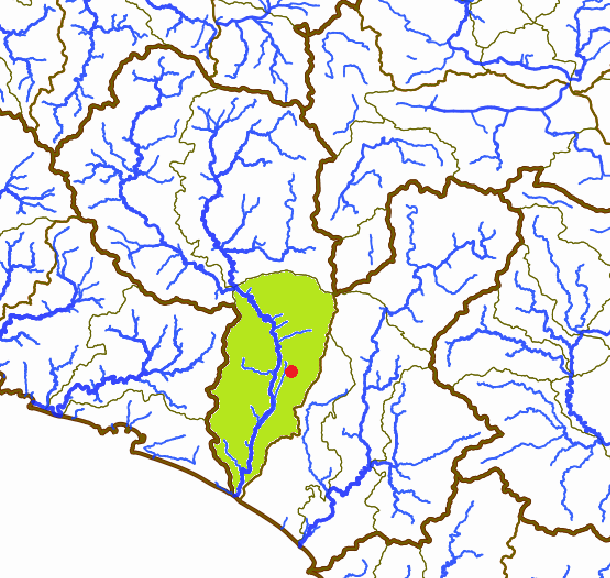
5. Aldzo1-LAA-AHon
Population: Arroyo Hondo
Hydrographic region: Armería-Coahuayana
Basin: Río Coahuayana
Subbasin: Lagunas Alcuzahue y Ámela
Locality: Arroyo Hondo, at bridge E of Cardona
